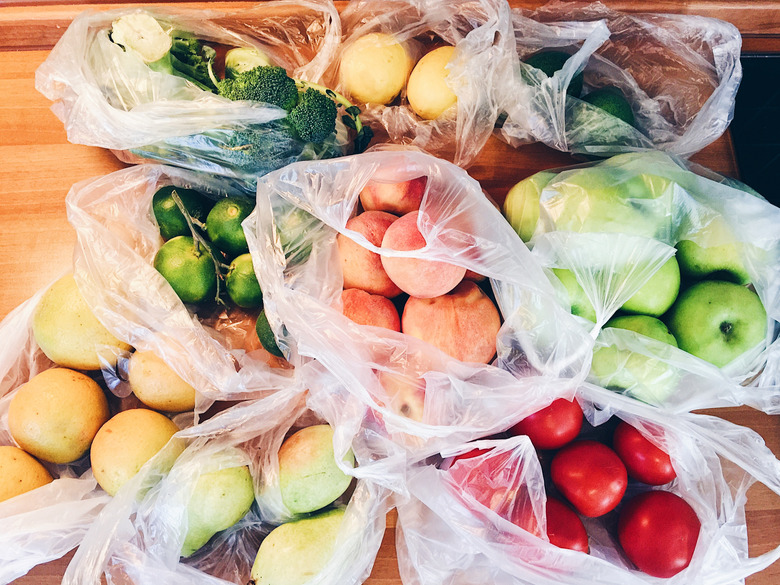Materials Used For Making Plastic Bags
Plastic bags are made from a ubiquitous polymer substance known as polyethylene. This begins as ethylene, commonly extracted from natural gases, then treated to become the polymer, forming long chains of carbon and hydrogen atoms. These chains can vary depending on what type of polyethylene is being used, but they all help create various types of plastic bags.
General Plastics
General Plastics
Plastics are created from a group of synthetic molecules known as polymers. Polymers are large, easy to create and made up of a repeating molecular pattern created by units called monomers. In plastic bags, these repeating structures are made of ethylene. Ethylene is chemically changed into polyethylene, the building block of all plastic bags. Polyethylene is made up of many winding chains of carbon atoms, interlaced with and bonded to hydrogen atoms. Because plastic is formed in this patterned structure, it is easy to manipulate into a variety of shapes and densities.
Sources
Sources
The source substances of polyethylene vary, but are almost always some form of fossil fuel. Both petroleum and natural gas are common sources and vital ingredients in almost all plastic bags available today. Properly refined, they yield ethylene, which is in turn made into polyethylene. This process is used mostly with natural gas, which yields a very flexible polyethylene substance that can be formed into nearly any shape and manufactured in any color.
HDPE Plastic
HDPE Plastic
HDPE stands for high density polyethylene, and is the most common type of polyethylene used to create shopping bags. This plastic is made of straight molecule chains that branch very little, staying linear from beginning to end. This linear structure creates a very strong material, which is why the common grocery bag is light yet can hold many times its own weight without tearing.
LDPE Plastic
LDPE Plastic
LDPE plastic is made from low density, branching chains of polymer materials. These polyethylene chains, rather than staying linear, spread out in many different combining lines. This creates a very light, almost filmlike plastic that is used to make the tear-away bags dry cleaners use for wrapping cleaned clothes.
LLDPE Plastic
LLDPE Plastic
Referring to linear low density polyethylene, these plastics do not branch, but also do not have the same strength as HDPE versions. This means that shopping bags created from LLDPE plastics need to be thicker and heavier that traditional grocery bags. The shiny bags using in clothing stores are a common example of bags made from this substance.
Environmental Information
Environmental Information
While shopping bag plastic is recyclable, it cannot be remade into an organic state, and once created must stay as a synthetic substance for the rest of its life. Instead of being recycled as new plastic bags, many bags are used to create other synthetic materials such as composite lumber. In general, plastic bags are the preferred environmental choice, not because of their recyclable qualities but because of their manufacturing process, which uses around 70 percent less energy and releases 50 percent fewer greenhouse gas particles than alternatives like paper bags.
References
Cite This Article
MLA
Lacoma, Tyler. "Materials Used For Making Plastic Bags" sciencing.com, https://www.sciencing.com/materials-used-making-plastic-bags-5267902/. 26 April 2018.
APA
Lacoma, Tyler. (2018, April 26). Materials Used For Making Plastic Bags. sciencing.com. Retrieved from https://www.sciencing.com/materials-used-making-plastic-bags-5267902/
Chicago
Lacoma, Tyler. Materials Used For Making Plastic Bags last modified March 24, 2022. https://www.sciencing.com/materials-used-making-plastic-bags-5267902/
